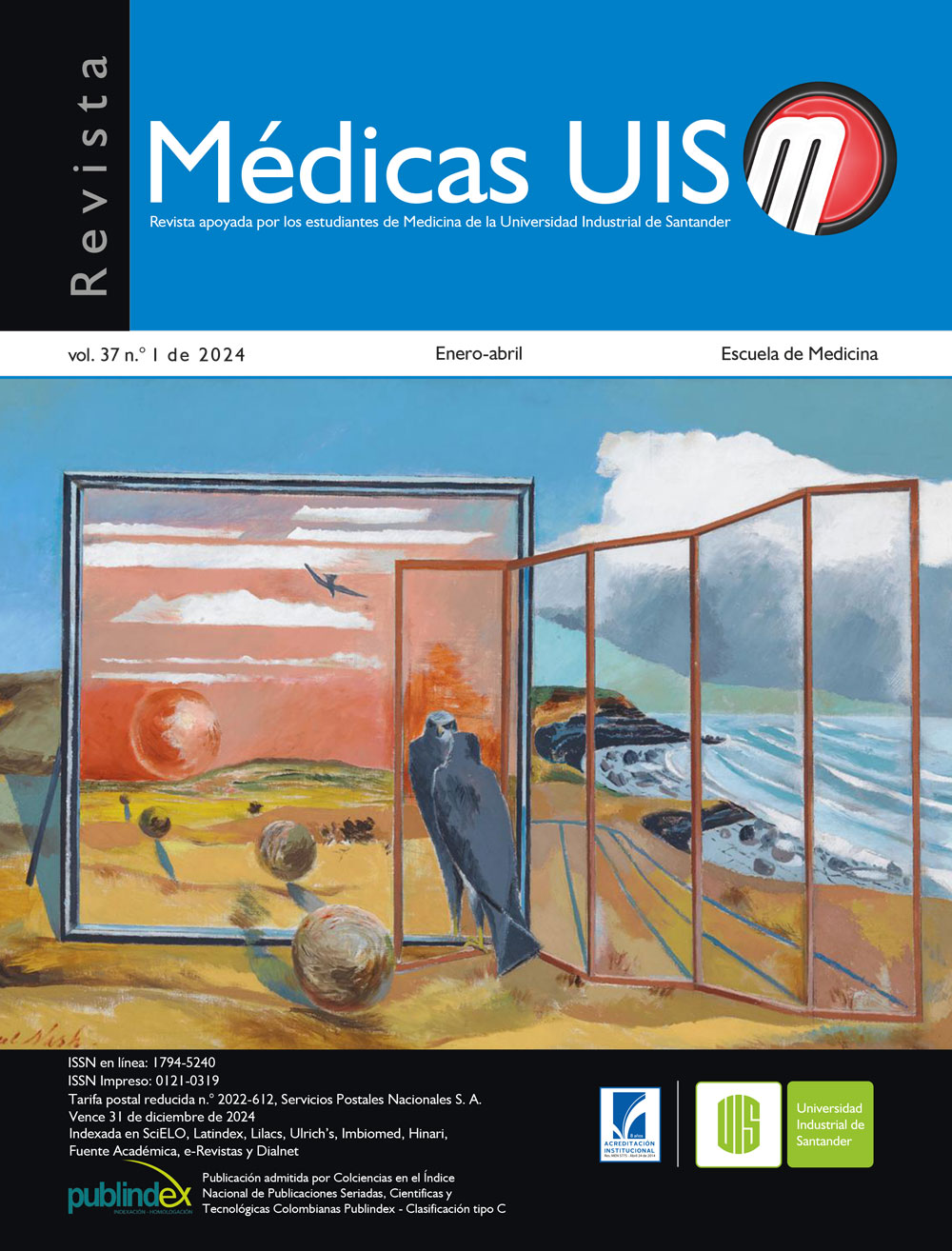Abstract
Boerhaave's syndrome is a rare pathology with a mortality rate of 30-50%. It consists of a spontaneous transmural tear of the esophagus secondary to a sudden increase in intraluminal esophageal pressure, which in only two reports in the literature has been causally associated with SARS-CoV-2 infection. We present the case of a 68-year-old male patient with a sudden onset clinical picture consisting of abundant episodes of emesis who subsequently presented respiratory deterioration associated with subcutaneous emphysema in the right hemithorax. Pneumonia due to SARS-CoV-2 and Boerhaave's Syndrome was documented, so he was taken to esophagography, and given the torpid post-surgical evolution, endoluminal vacuum therapy was indicated with favorable progress after 4 months of follow-up. This pathology represents a diagnostic challenge due to its nonspecific clinical presentation, so the delay in recognition will directly impact the therapeutic approach and prognosis.
References
Tarazona MAD, Chaves CER, Mateus JFI, Comba FAR, Rosso JD, Uribe MCA. Boerhaave syndrome: Successful conservative treatment. Case report and literature review. Int J Surg Case Rep. 2023;107:108289.
Tellechea JI, Gonzalez JM, Miranda-García P, Culetto A, D’Journo XB, Thomas PA, et al. Role of Endoscopy in the Management of Boerhaave Syndrome. Clin Endosc. 2018;51(2):186-191.
David A. Katzka. Trastornos esofágicos causados por fármacos, traumatismos e infecciones. En: Feldman M, Friedman LS, Brandt LJ, editores. Sleisenger Y Fordtran Enfermedades Digestivas Y Hepáticas. Barcelona: Elsevier, Inc; 2022. p. 661-669.
Huu Vinh V, Viet Dang Quang N, Van Khoi N. Surgical management of esophageal perforation: role of primary closure. Asian Cardiovasc Thorac Ann. 2019;27(3):192-198.
Han C, Duan C, Zhang S, Spiegel B, Shi H, Wang W, et al. Digestive Symptoms in COVID-19 Patients With Mild Disease Severity: Clinical Presentation, Stool Viral RNA Testing, and Outcomes. Am J Gastroenterol. 2020;115(6):916-923.
Allaway MGR, Morris PD, Sinclair BJL, Richardson AJ, Johnston ES, Hollands MJ. Management of Boerhaave syndrome in Australasia: a retrospective case series and systematic review of the Australasian literature. ANZ J Surg. 2021;91(7-8):1376-1384.
Tellechea JI, Gonzalez JM, Miranda-García P, Culetto A, D’Journo XB, Thomas PA, et al. Role of Endoscopy in the Management of Boerhaave Syndrome. Clin Endosc. 2018;51(2):186-191.
Pezzetta E, Kokudo T, Uldry E, Yamaguchi T, Kudo H, Ris HB, et al. The surgical management of spontaneous esophageal perforation (Boerhaave’s syndrome) ‒ 20 years of experience. Biosci Trends. 2016;10(2):120-124.
Shaker H, Elsayed H, Whittle I, Hussein S, Shackcloth M. The influence of the ‘golden 24-h rule’ on the prognosis of esophageal perforation in the modern era. Eur J Cardiothorac Surg. 2010;38(2):216-222.
Ríos ZA, Martínez HLF, Ortiz EMA, Durán H, Munitiz RV, Parrilla PP. Perforaciones esofágicas. Presentación de 23 casos. Gastroenterol Hepatol. 2000;23(8):379–383.
Schweigert M, Beattie R, Solymosi N, Booth K, Dubecz A, Muir A, et al. Endoscopic stent insertion versus primary operative management for spontaneous rupture of the esophagus (Boerhaave syndrome): an international study comparing the outcome. Am Surg. 2013;79(6):634-640.
Meloy P, Bhambri A. Esophageal Rupture Associated With COVID-19: A Novel Case Report. Cureus. 2020;12(12):e12256.
Saad A, Sharma A, Dhillon S, Jaunoo S. P-EGS25 Boerhaave’s Syndrome Secondary to Symptomatic COVID-19 Infection. Br J Surg. 2021;108(suppl 9):znab430.085.
Rahman A, Alqaisi S, Downing C. Unusual Presentation of COVID Pneumonia as Esophageal Rupture Ended With Successful Management. Cureus. 2021;13(8):e17348.
Schweigert M, Santos H, Solymosi N, Yankulov A, Fernández M, Beattie R, et al. 2016. Spotlight on esophageal perforation: A multinational study using the Pittsburgh esophageal perforation severity scoring system. J Thorac Cardiovasc Surg. 2016;151(4):1002–1011.
Elke G, van Zanten ARH, Lemieux M, McCall M, Jeejeebhoy KN, Kott M, et al. Enteral versus parenteral nutrition in critically ill patients: an updated systematic review and meta-analysis of randomized controlled trials. Crit Care. 2016;20(1):117-130.
Abdulsada M, Sealock RJ, Cornwell L, Ketwaroo GA. Endoluminal vacuum therapy of esophageal perforations. VideoGIE. 2020;5(1):8-10.
Szymanski K, Ontiveros E, Burdick JS, Davis D, Leeds SG. Endolumenal Vacuum Therapy and Fistulojejunostomy in the Management of Sleeve Gastrectomy Staple Line Leaks. Case Rep Surg. 2018 2018(1):1–3.
Gonzalez JM, Duran R, Vanbiervliet G, Lestelle V, Gomercic C, Gasmi M, et al. Double-type metallic stents efficacy for the management of post- operative fistulas, leakages, and perforations of the upper gastrointestinal tract. SurgEndosc. 2014;29(7):2013–2018.
Vidarsdottir H, Blondal S, Alfredsson H, Geirsson A, Gudbjartsson T. Oesophageal Perforations in Iceland: a Whole Population Study on Incidence, Aetiology and Surgical Outcome. Thorac Cardiovascular Surg. 2010;58(8):476–480.
Turner AR, Collier SA, Turner SD. Boerhaave Syndrome. [Actualizado 2023 Dec 4]. En: StatPearls [Internet]. Treasure Island (FL): StatPearls Publishing; 2024. Disponible en: https://www.ncbi.nlm.nih.gov/books/ NBK430808/
Wigley C, Athanasiou A, Bhatti A, Sheikh A, Hodson J, Bedford M, et al. Does the Pittsburgh severity score predict outcome in esophageal perforation? Dis Esophagus. 2019;32(2).

This work is licensed under a Creative Commons Attribution 4.0 International License.
Copyright (c) 2024 Médicas UIS

